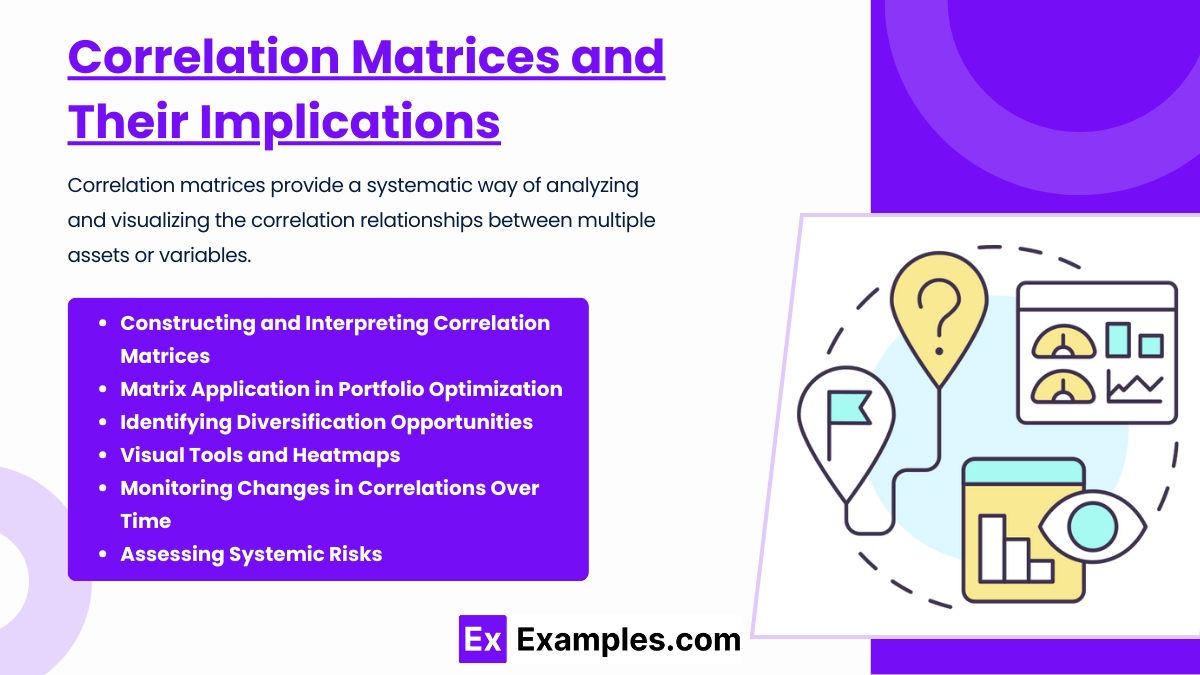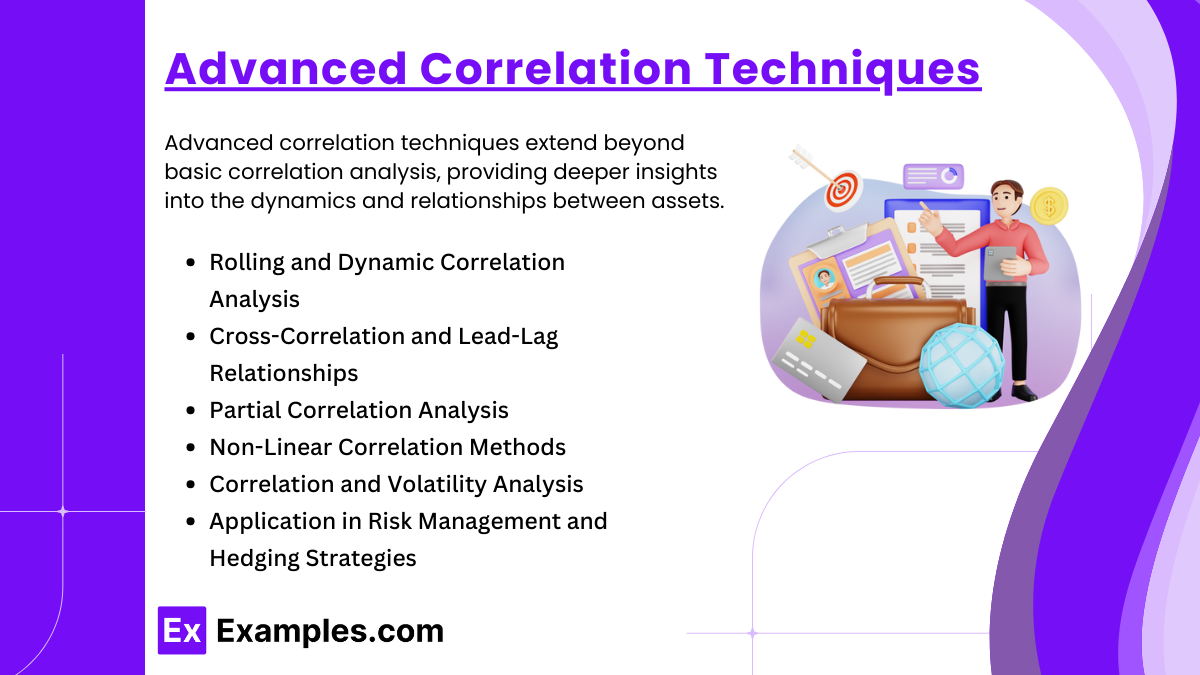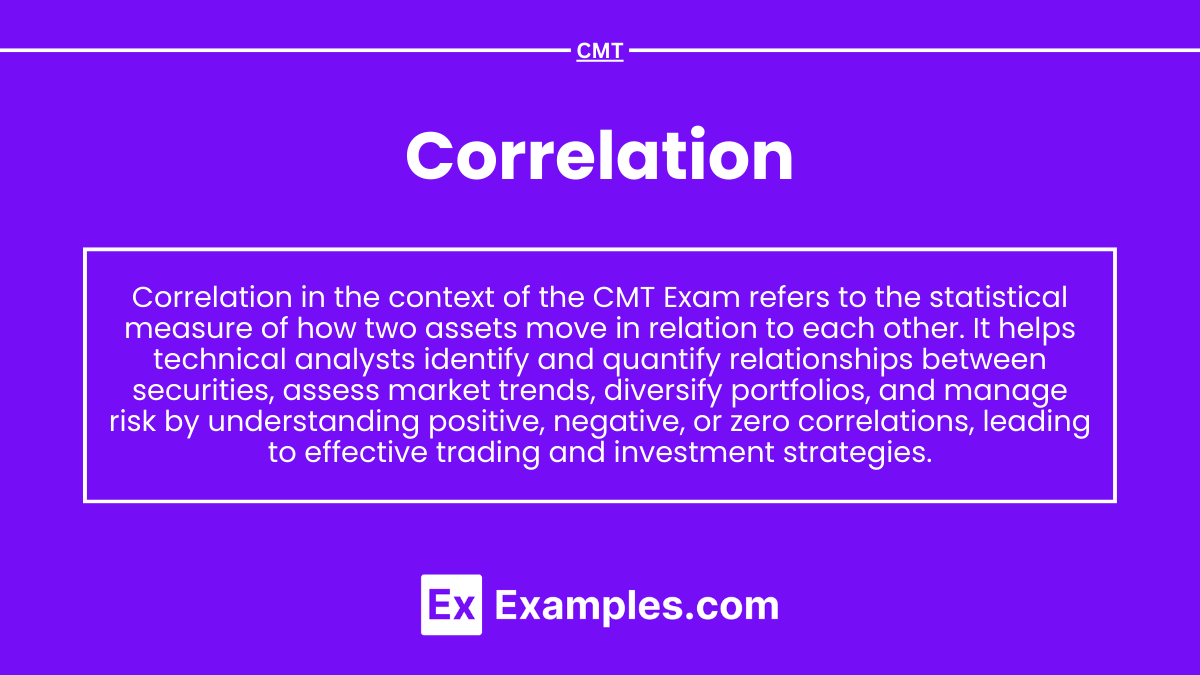Preparing for the CMT Exam requires a deep understanding of correlation, a key concept in technical analysis. Mastering correlation helps identify relationships between assets, measure diversification, and assess market trends. It is crucial for analyzing asset movements, risk management, and portfolio optimization, all vital skills for success in the CMT Exam.
Learning Objective
In studying “Correlation” for the CMT Level 2 Exam, you should learn to understand the statistical relationships between different financial instruments. Focus on how correlation is measured, interpreted, and applied in portfolio management and market analysis. Examine its use in identifying diversification benefits, understanding market dynamics, and predicting asset movements. Evaluate correlation matrices and their implications for asset allocation strategies. Study various types of correlations such as positive, negative, and zero correlation, and understand their significance in trend analysis. Apply this knowledge to practical examples, including identifying market inefficiencies, risk management, and developing advanced trading strategies in technical analysis.
Measuring and Understanding Correlation

- Definition and Types of Correlation
Correlation refers to the statistical relationship between two or more variables or data sets. It indicates whether and how strongly pairs of variables are related. For example, a positive correlation between two stock prices means they tend to move in the same direction, while a negative correlation indicates they move in opposite directions. Zero correlation shows no discernible relationship between the movements of the assets. - Positive, Negative, and Zero Correlation
Positive correlation occurs when an increase in one variable corresponds to an increase in another. For example, if stock A’s price rises and stock B’s price also rises, they are positively correlated. Negative correlation is present when an increase in one variable leads to a decrease in another, like a stock price rising as interest rates decrease. Zero correlation signifies no linear relationship, meaning the variables move independently of each other without predictable trends. - Correlation Coefficient
The correlation coefficient is a numerical value, typically represented as “r,” that quantifies the strength and direction of a linear relationship between variables. The value ranges from -1 to +1. A coefficient close to +1 indicates a strong positive correlation, while a value near -1 denotes a strong negative correlation. A value around 0 indicates no linear correlation between the variables. This measurement is central in technical analysis, helping quantify relationships between market data points. - Strength and Significance
The absolute value of the correlation coefficient represents the strength of the relationship between two variables, where values closer to 1 or -1 indicate stronger relationships. However, significance testing determines if a correlation is statistically meaningful and not due to random chance. Analysts often check p-values alongside correlation coefficients to assess the reliability and usefulness of their findings in making trading or investment decisions. - Applications in Technical Analysis
Correlation helps identify relationships between different securities, assisting traders in creating diversified portfolios to manage risk. For example, assets with low or negative correlation provide diversification benefits, reducing overall portfolio volatility. Correlation can also reveal market trends, allowing analysts to determine if multiple securities are moving together due to broader economic influences or sector-specific changes. - Limitations and Pitfalls
While correlation indicates the degree of relationship, it does not imply causation; correlated variables may be influenced by an underlying third factor rather than a direct cause-and-effect link. Additionally, spurious correlations can occur due to chance relationships in large data sets, leading to potentially misleading conclusions. Correlation also assumes linearity, making it less effective in non-linear data relationships often seen in financial markets. - Dynamic Nature of Correlation
Correlation between assets can change over time, especially during periods of high market volatility, economic crises, or macroeconomic shifts. For example, during financial turmoil, previously low-correlated assets may suddenly move in lockstep, reducing diversification benefits. As a result, technical analysts must continuously monitor correlations and adapt their strategies to account for these fluctuations.
Applications of Correlation in Technical Analysis

Correlation plays a significant role in technical analysis by offering insights into market behaviors, asset movements, and diversification strategies. Here is a detailed explanation of its applications:
- Portfolio Diversification
By examining correlations among different assets, traders and investors can create diversified portfolios aimed at reducing risk. Holding assets that are negatively or minimally correlated can help balance gains and losses within a portfolio. For instance, if one asset decreases in value while another increases, it helps to stabilize overall returns, lowering the impact of market fluctuations. - Market Behavior Analysis
Correlation helps in understanding how different markets or asset classes move in relation to each other. For example, analyzing how stocks, bonds, and commodities react to market events provides insights into broader market trends. High correlations between assets may indicate systematic risks, while low correlations can point to market segmentation. - Asset Allocation Strategies
Correlation analysis is critical for determining optimal asset allocation. By evaluating correlations among various assets, technical analysts can allocate capital in a way that maximizes returns for a given level of risk. Allocating more weight to uncorrelated or negatively correlated assets can enhance portfolio performance while reducing volatility. - Trend and Cycle Analysis
Correlation is used to validate and reinforce trend and cycle analyses. For instance, a strong correlation between sector performance and overall market movement may indicate a broad trend. Correlation can also help determine if an emerging trend is sector-specific or indicative of a larger market cycle. - Identifying Diversification Benefits
Correlation helps assess the benefits of diversification by identifying the degree of co-movement between different assets. Diversification is most effective when assets are uncorrelated or negatively correlated. This can lead to a reduction in unsystematic risk and contribute to more stable long-term returns. - Risk Management
In risk management, understanding correlations allows for effective hedging strategies. If a portfolio has high exposure to a particular asset class, correlated assets can be used to hedge against potential adverse movements. This minimizes the impact of market volatility and protects against significant losses. - Trading Strategies and Market Predictions
Correlation is used in developing trading strategies by identifying potential predictive relationships between assets. For instance, a strong positive correlation between a currency pair and a commodity may help traders anticipate future price movements based on market conditions. Cross-market correlations can offer signals for trading opportunities, enhancing strategy effectiveness.
Correlation Matrices and Their Implications

Correlation matrices provide a systematic way of analyzing and visualizing the correlation relationships between multiple assets or variables. This tool is widely used in technical analysis, portfolio management, and market analysis due to its comprehensive capabilities.
- Constructing and Interpreting Correlation Matrices
A correlation matrix is a table showing correlation coefficients between sets of variables. The matrix typically displays values between -1 and +1, representing the degree and direction of correlation between each pair. By analyzing the matrix, technical analysts can quickly identify how various assets or securities relate to one another, spotting patterns and clusters of high or low correlations. - Matrix Application in Portfolio Optimization
Correlation matrices play a key role in optimizing portfolios. By analyzing the correlations between different assets, portfolio managers can identify securities that move independently or in opposite directions. This information is essential for maximizing diversification, reducing portfolio risk, and achieving the desired risk-return balance. Minimizing exposure to highly correlated assets helps reduce the impact of market-specific movements. - Identifying Diversification Opportunities
A correlation matrix highlights opportunities for diversification by revealing which assets are negatively or weakly correlated. Such assets can be included in a portfolio to enhance stability and lower risk. In practice, this helps investors manage volatility by minimizing the effects of adverse market movements on overall portfolio value. - Visual Tools and Heatmaps
Correlation matrices can be visualized using heatmaps, where colors represent the strength and direction of correlation values. This visualization makes it easier for analysts to identify patterns, clusters, or anomalies in asset relationships. Heatmaps enhance the interpretability of complex correlation data and provide actionable insights for market decisions. - Monitoring Changes in Correlations Over Time
Correlations between assets can change due to shifts in macroeconomic factors, market sentiment, or geopolitical events. By regularly updating and analyzing correlation matrices, analysts can adapt their strategies to reflect these changes. This dynamic approach helps maintain effective diversification and adjust hedging or trading strategies as needed. - Assessing Systemic Risks
Correlation matrices can reveal potential systemic risks within the market. High correlations across different asset classes may indicate a heightened risk of market-wide downturns, while lower correlations suggest less systemic exposure. This understanding aids in developing risk management strategies that mitigate exposure to widespread market shocks. - Practical Implications for Trading and Strategy Development
Correlation matrices offer practical insights for building and refining trading strategies. For example, a high positive correlation between two assets may signal co-movement trends, while a strong negative correlation could indicate potential hedging opportunities. Analyzing correlation changes can also help anticipate market movements, improving the accuracy and effectiveness of trading models.
Advanced Correlation Techniques

Advanced correlation techniques extend beyond basic correlation analysis, providing deeper insights into the dynamics and relationships between assets. These methods are particularly valuable for technical analysts seeking to capture more nuanced trends, market movements, and interdependencies. Here’s a breakdown of the key techniques and their applications:
- Rolling and Dynamic Correlation Analysis
Unlike static correlation, which evaluates the relationship between assets over a fixed period, rolling or dynamic correlation tracks changes over a moving window of time. This approach reveals how correlations evolve due to market events, economic shifts, or changing investor sentiment. It helps analysts identify periods of high or low correlation, enabling more responsive portfolio adjustments and hedging strategies. - Cross-Correlation and Lead-Lag Relationships
Cross-correlation assesses how one asset’s movement relates to another’s with a time delay or lag. This technique can help identify lead-lag relationships, where one asset’s price movements may predict another’s. For example, if changes in a leading market index consistently precede moves in a specific stock, cross-correlation can be used to anticipate potential trends or reversals. - Partial Correlation Analysis
Partial correlation measures the relationship between two variables while controlling for the influence of other variables. This method is especially useful when analyzing financial markets where multiple factors may drive asset movements simultaneously. It provides a clearer picture of the direct relationship between variables, isolating the unique impact one asset has on another. - Multivariate Correlation Techniques
Advanced multivariate methods, such as principal component analysis (PCA) or factor analysis, help identify common factors driving correlations among multiple assets. By reducing dimensionality and identifying key components that contribute to asset movements, analysts can better understand complex market structures and build more efficient models for diversification and risk management. - Non-Linear Correlation Methods
Financial markets often exhibit non-linear behaviors that traditional linear correlation measures may not capture. Techniques such as rank correlation (Spearman’s correlation), copula functions, and other non-linear approaches provide a more accurate depiction of relationships in complex markets. These methods are valuable for analyzing assets that may have hidden dependencies or exhibit non-linear patterns of movement. - Correlation and Volatility Analysis
Correlation is often related to market volatility. During periods of market stress, asset correlations may increase, leading to reduced diversification benefits. Analyzing how correlations behave in different volatility regimes allows technical analysts to develop robust risk management strategies and adapt portfolios accordingly. For example, using volatility-adjusted correlation metrics can improve hedging and trading strategies during turbulent times. - Application in Risk Management and Hedging Strategies
Advanced correlation techniques enhance the ability to manage risk and implement effective hedging strategies. For instance, using dynamic correlation models helps identify changes in asset relationships that can lead to higher market risks. These models are applied to create more effective hedge portfolios that adapt to shifting market conditions, minimizing exposure and mitigating losses.
Examples
Example 1: Stock and Bond Market Correlation Analysis
When analyzing a portfolio, a technical analyst might observe that stocks and bonds have historically shown a negative correlation. During a market downturn, bonds often gain value as investors seek safer assets. This insight can be used to build a diversified portfolio that balances risk and reward by including both asset classes.
Example 2: Currency Pair Correlation in Forex Markets
Suppose an analyst is trading in forex markets and wants to trade the EUR/USD and GBP/USD pairs. Understanding their historical positive correlation helps the analyst assess potential risks, as movements in one pair may predict or influence the behavior of the other. This correlation helps in setting stop-losses or taking parallel positions.
Example 3: Sector Correlation with Market Index
Analyzing the correlation of a particular sector (e.g., technology) with a broad market index (e.g., S&P 500) helps an analyst determine the sector’s relative strength and contribution to overall market trends. If a high positive correlation exists, it implies that the sector’s performance is closely tied to the market, impacting investment and risk strategies.
Example 4: Commodity and Currency Correlation
A technical analyst studying commodity prices, such as gold, may observe its inverse correlation with the U.S. dollar. This insight can be used to hedge currency risk or take positions that benefit from changes in market conditions affecting both the commodity and currency markets.
Example 5: Correlation During Market Stress Periods
During periods of market stress, correlations between traditionally uncorrelated assets (e.g., equities and commodities) may suddenly increase. Understanding this phenomenon helps analysts develop strategies to manage diversification risk, adjust hedges, and anticipate potential changes in portfolio behavior during volatile market conditions.
Practice Questions
Question 1
Which of the following correlation coefficients indicates the strongest linear relationship between two variables?
A) 0.3
B) -0.85
C) 0
D) 0.7
Answer: B) -0.85
Explanation:
The strength of the linear relationship between two variables is represented by the absolute value of the correlation coefficient. The closer the absolute value is to 1, the stronger the linear relationship. In this case, -0.85 has the largest absolute value, indicating the strongest linear relationship. The negative sign simply indicates that it is an inverse relationship.
Question 2
What does a correlation coefficient of 0 signify?
A) A perfect positive relationship
B) No linear relationship between the variables
C) A perfect inverse relationship
D) A strong relationship but nonlinear
Answer: B) No linear relationship between the variables
Explanation:
A correlation coefficient of 0 indicates that there is no linear relationship between the variables being analyzed. This means that changes in one variable do not predictably lead to changes in the other variable. It does not, however, rule out the possibility of a nonlinear relationship.
Question 3
In a correlation matrix, a value of 1 between two assets indicates:
A) No relationship between the assets
B) A perfect inverse relationship
C) A perfect positive correlation
D) A negative correlation
Answer: C) A perfect positive correlation
Explanation:
A correlation value of 1 indicates a perfect positive correlation, meaning that as one asset increases, the other also increases by a predictable amount. This kind of relationship suggests that the assets move in perfect sync in the same direction. A value of -1 would indicate a perfect inverse relationship, and a value of 0 would mean no correlation.


